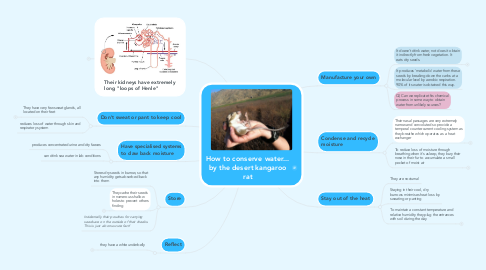
1. Their kidneys have extremely long "loops of Henle"
1.1. Could this help us manage our waste water, so that we claw back the maximum moisture rather than discarding it? Such a filtration system might benefit from being extensive in length. Or perhaps this is two systems: one to extract the water and one to purify it for onward use.
2. Don't sweat or pant to keep cool
2.1. They have very few sweat glands, all located on their feet
2.1.1. What material should we use to store our water? What properties might reduce water loss. Wax? Am thinking of how sweaty you can get inside a cheap non-breathable waxed jacket. Water can't easily escape.
2.2. reduces loss of water through skin and respiratory system
3. Have specialised systems to claw back moisture
3.1. produces concentrated urine and dry faeces
3.2. can drink sea water in lab conditions
4. Store
4.1. Stores dry seeds in burrow, so that any humidity gets absorbed back into them
4.2. They cache their seeds in numerous shallow holes to prevent others finding
4.2.1. Diversification could make sense - many stores rather than one - for several reasons
4.3. Incidentally their pouches for carrying seeds are on the outside of their cheeks. This is just a bonus cute fact!
5. Reflect
5.1. they have a white underbelly
5.1.1. Could suggest that our stores or mechanisms might be light in colour
6. Manufacture your own
6.1. It doesn't drink water, not does it obtain it indirectly from fresh vegetation. It eats dry seeds.
6.1.1. (The science bit: Metabolic energy derives from processes of oxidation and reduction. When energy is consumed in a process, chemical energy is made available for synthesis of ATP as one atom gives up electrons (becomes oxidized) and another atom accepts electrons (becomes reduced).)
6.2. It produces 'metabolic' water from these seeds by breaking down the carbs at a molecular level by aerobic respiration. 90% of its water is obtained this way.
6.3. Q) Can we replicate this chemical process in some way to obtain water from unlikely sources?
7. Condense and recycle moisture
7.1. Their nasal passages are very extremely narrow and convoluted so provide a temporal counter-current cooling system as they breathe which operates as a heat exchanger
7.1.1. During exhalation, these cool the air and extract moisture
7.1.2. Might it be helpful if any pipework we have is convoluted rather than straight? Could this prevent evaporation?
7.2. To reduce loss of moisture through breathing when it's asleep, they bury their nose in their fur to accumulate a small pocket of moist air
7.2.1. Should we insulate our water store in some way to prevent evaporation?
8. Stay out of the heat
8.1. They are nocturnal
8.2. Staying in their cool, dry burrows minimises heat loss by sweating or panting
8.3. To maintain a constant temperature and relative humidity they plug the entrances with soil during the day
8.3.1. Is this a way for us to preserve the water we harvest? Should we keep it in an underground chamber with a closed entrance?
